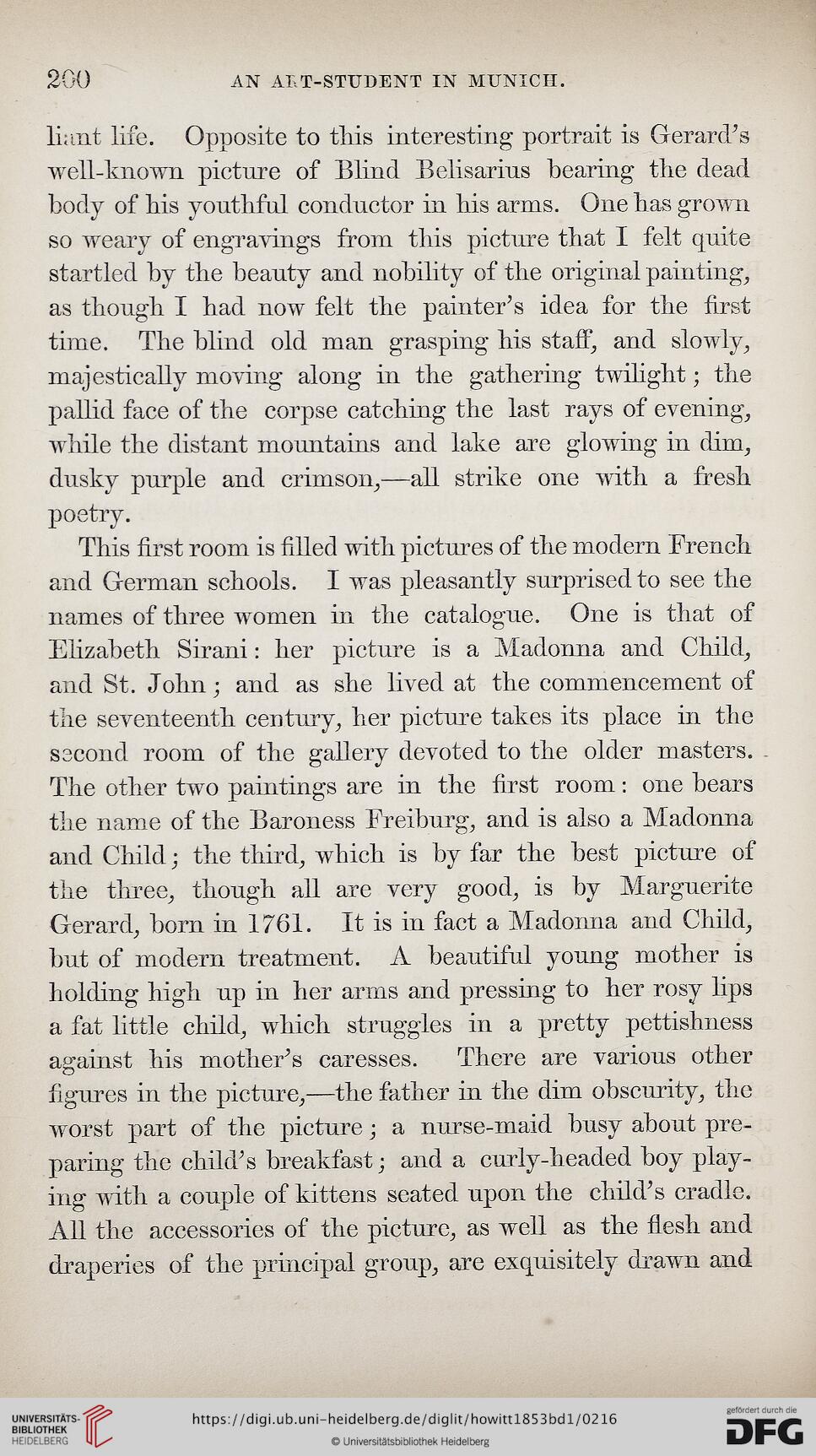200
AN ALT-STUDENT IN MUNICH.
Hunt life. Opposite to this interesting portrait is Gerard’s
well-known picture of Blind Belisarius bearing the dead
body of his youthful conductor in his arms. One has grown
so weary of engravings from this picture that I felt quite
startled by the beauty and nobility of the original painting,
as though I had now felt the painter’s idea for the first
time. The blind old man grasping his staff, and slowly,
majestically moving along in the gathering twilight; the
pallid face of the corpse catching the last rays of evening,
while the distant mountains and lake are glowing in dim,
dusky purple and crimson,—all strike one with a fresh
poetry.
This first room is filled with pictures of the modern French
and German schools. I was pleasantly surprised to see the
names of three women in the catalogue. One is that of
Elizabeth Sirani: her picture is a Madonna and Child,
and St. John; and as she lived at the commencement of
the seventeenth century, her picture takes its place in the
second room of the gallery devoted to the older masters.
The other two paintings are in the first room: one bears
the name of the Baroness Freiburg, and is also a Madonna
and Child; the third, which is by far the best picture of
the three, though all are very good, is by Marguerite
Gerard, born in 1761. It is in fact a Madonna and Child,
but of modern treatment. A beautiful young mother is
holding high up in her arms and pressing to her rosy bps
a fat little child, which struggles in a pretty pettishness
against his mother’s caresses. There are various other
figures in the picture,—the father in the dim obscurity, the
worst part of the picture; a nurse-maid busy about pre-
paring the child’s breakfast; and a curly-headed boy play-
ing with a couple of kittens seated upon the child’s cradle.
All the accessories of the picture, as well as the flesh and
draperies of the principal group, are exquisitely drawn and
AN ALT-STUDENT IN MUNICH.
Hunt life. Opposite to this interesting portrait is Gerard’s
well-known picture of Blind Belisarius bearing the dead
body of his youthful conductor in his arms. One has grown
so weary of engravings from this picture that I felt quite
startled by the beauty and nobility of the original painting,
as though I had now felt the painter’s idea for the first
time. The blind old man grasping his staff, and slowly,
majestically moving along in the gathering twilight; the
pallid face of the corpse catching the last rays of evening,
while the distant mountains and lake are glowing in dim,
dusky purple and crimson,—all strike one with a fresh
poetry.
This first room is filled with pictures of the modern French
and German schools. I was pleasantly surprised to see the
names of three women in the catalogue. One is that of
Elizabeth Sirani: her picture is a Madonna and Child,
and St. John; and as she lived at the commencement of
the seventeenth century, her picture takes its place in the
second room of the gallery devoted to the older masters.
The other two paintings are in the first room: one bears
the name of the Baroness Freiburg, and is also a Madonna
and Child; the third, which is by far the best picture of
the three, though all are very good, is by Marguerite
Gerard, born in 1761. It is in fact a Madonna and Child,
but of modern treatment. A beautiful young mother is
holding high up in her arms and pressing to her rosy bps
a fat little child, which struggles in a pretty pettishness
against his mother’s caresses. There are various other
figures in the picture,—the father in the dim obscurity, the
worst part of the picture; a nurse-maid busy about pre-
paring the child’s breakfast; and a curly-headed boy play-
ing with a couple of kittens seated upon the child’s cradle.
All the accessories of the picture, as well as the flesh and
draperies of the principal group, are exquisitely drawn and




